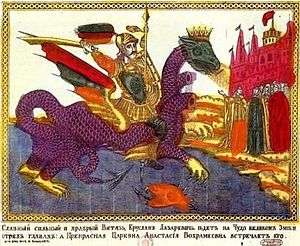Yeruslan Lazarevich

Yeruslan Lazarevich (Cyrillic: Еруслан Лазаревич), also known as Eruslan Lazarevich or in the Tatar original Uruslan, is the Russian folk literature hero of The Tale of Eruslane Lazarevic, recounting the many military and amorous adventures of a young and beautiful hero, a tale which was much liked by the old Russian readers due to a variety of its content and by appearing frequently on the lubok, was widely spread among the people. Its influence is noticeable even on some retelling of tales about Ilya of Murom.
Erusulan, Uruslan, and the German form Jeruslan Lasarewitch are some of the variant spellings.
Origins of the legend
One theory (Vladimir Stasov, 1868) is that the legend was an adaptation of the exploits of Rustem, hero of the Persian epic Shah Nameh.[1][2] Possibly this story was introduced by the Turkic (Tatar). One of the similarities is the combat between father and son, Rustem and Sohrab, although this has parallels worldwide.[2] Another is Rustem's campaign, in Mazandaran for the release of the Persian king Kay Kaus.
The father of Yeruslan (according to the Undolsky manuscript version) is Zalazar, retaining the name of the father of Rustem, Zal-Zar; the King of Persia is Kirkous, altered from Kay Kaus of the Shah Nameh; the horse of Uruslan is Arash, while the horse of Rustem was Rahsh. Uruslan himself can be equated with Rustam, since he was being called Arslan (Lion) in Turkic versions. Between the two above-mentioned episodes, the first of which is the beginning of the second – the tales were ended, to immediately place the other adventures of Uruslan (with little connection in the original versions), such as the meeting with a Russian hero Ivan, the fight with him, then their fraternisation and mutual assistance in the search by Uruslan for Ivan’s daughter taken by Theodulus-zmeyya Kandauly Feodulovny; the meeting of Uruslan with beautiful princesses, held by a giant-keeper, Ivashko; the battle with the sea king dragon saving Princess Anastasiya Vahramyeevna, his marriage to Princess Sunflower City and so on. These adventures of Uruslan do not have a direct correspondence in the adventures of an Iranian Rustem, but find parallels in the various oriental tales.
The Tale of Eruslane Lazarevic is of considerable interest for the history of fairy tales about Ilya of Murom. On the one hand, on some adventures of the Murom heroes there are the same motives that went into the tale of Eruslane Lazarevic. For example, a meeting of Ilya with Nightingale the robber, his coming to Kiev and his relationship with Prince Vladimir is reminiscent of Eruslan Lazarevic meeting with Ivashko hero and his arrival to the king of Dalmatia; the meeting of Ilya with Korolevichnoy can be associated with the meeting of Yeruslan with beautiful princesses; then the two knights fight with their sons not known of them, and so on. On the other hand, some epic poems, and especially tales about Ilya of Murom had a cheap popular direct effect in people, which it has in common with the tale of Eruslane Lazarevic.
Publications
The Tale of Eruslane Lazarevic manuscript was published, first by Vukol Undolski and N. S. Tikhonravov,[3] and then by the manuscript Archive of Pogodinskaya, by N. Kostomarov.[4] The text of the cheap popular personal tales was printed by D. A. Rovinsky.[5] Both record tales of the 17th century represented in two editions, of which the edition of the Undolskogo (Undolsky collection) list is considered more valuable, as it has a more logical connection between the separate adventures of the hero, names in it the hero as Sir Uruslan and preserved in greater purity, in some names of other characters.
Explanatory notes
References
- Citations
- ↑ Stasov (1868), p. 175: "Наш Еруслан Лазаревич есть не кто иной, как знаменитый Рустем персидской поэмы Шах-Намэ (Our Yerslan Lazarevich is none other than the famous Rustem of the Persian poem Shah-Nameh".
- 1 2 Potter, Murray Anthony (1902). Sohrab and Rustem: The Epic Theme of a Combat Between Father and Son. D. Nutt. pp. 32–33, note4.
Busse (p. 22) following Stāsof (Vjestnik Evropy, 1868, p. 183ff.) considers this version to be a working over of the Shah Nameh.. it is by no means certain.
- ↑ Летописи русской литературы» («Annals of Russian Literature»), Volume II, part. II, M., 1859
- ↑ «Памятники старины русской литературы» («Monuments of Russian Literature»), Vol. II, 1880
- ↑ D. A. Rovinsky's Народные русские картинки (Russian folk pictures). SPb., 1881. T. I, sec. 51, T. V, sec. 115. / / Открытая русская электронная библиотека (Open Russian Electronic Library)
- Bibliography
- "Tekst russkoy narodnoy skazki «O slavnom, moguchem bogatyr Yeruslan Lazarevich»" Текст русской народной сказки «О славном, могучем богатыре Еруслане Лазаревиче» [The text of Russian folk tale of the brave, the mighty hero Eruslane Lazarevic]. Archived from the original on 2010-04-13. (in Russian)
- Savushkina, Nina Ivanova, ed. (1965). Yeruslan Lazarevich Еруслан Лазаревич. Русские народные сказки. Худож. лит-ра. pp. 260–281.
- anonymous (2014). Skazka o slavnom, moguchem bogatyre Yeruslane Lazareviche Сказка о славном, могучем богатыре Еруслане Лазаревиче [Tale of the glorious, mighty hero Yeruslan Lazarevich]. Русские народные сказки. Directmedia. p. 393–421.
- Stasov, Vladimir (1868). "Происхождение русских былин" [Origin of the Russian epic]. Vestnik Evropy. 1.
- Further reading
- A. N. Pypin. Очерк литературной истории старинных повестей и сказок русских (Essay on the literary history of ancient legends and tales of Russian) (1858);
- Alexander Veselovsky in the «Истории русской словесности» ("History of Russian Literature") by Alexey Galakhov (ed. 2, 1880, p. 431);
- Vsevolod Miller. Экскурсы в область русского народного эпоса (Excursions to the region of the Russian folk epic). 1892, digression VI;
- Vsevolod Miller. Материалы для истории былинных сюжетов (Materials for the history of epic stories) / Ethnographic Survey, 1892, Vol. XII.
Notes
| Wikimedia Commons has media related to Yeruslan Lazarevich. |
In writing this article was incorporates text from the Encyclopædia Britannica Eleventh Edition (1890-1907).